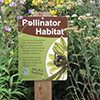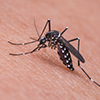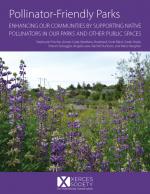"Pesticide" is an umbrella term that includes—but is not limited to—insecticides, herbicides, fungicides, and rodenticides. Each year in the United States, more than a billion pounds of pesticides are applied across home gardens, parks, and farms to manage unwanted weeds, insects, diseases and other “pests”. The majority of pesticides used are “broad-spectrum” meaning they kill broadly. Contamination resulting from the extensive use of pesticides has been tied to the decline of species important to ecosystems, including pollinators.
At the Xerces Society, all of our conservation efforts address the risks of pesticides, whether we are working with a home gardener, a state wildlife agency, or a farmer. Xerces works to increase awareness of ecological pest management and to reduce reliance on and use of pesticides. Ecological pest management seeks to reduce the impact of pests to tolerable levels and focuses on increasing a system’s resiliency to pest presence (for instance by creating habitat for natural enemies), thus avoiding the need for pesticide use.
Pesticide History and Regulation
Until the last century, pesticides were made from plant extracts or mineral-based materials such as copper, and people relied much more heavily on preventative techniques such as crop rotations and sanitation. In the 20th century, “synthetic” pesticides were designed to “control” a variety of “pests”. Examples include DDT, glyphosate (found in a number of products including Roundup), 2,4-D (in many weed and feed products), and imidacloprid (one of the neonicotinoid insecticides). While new synthetic pesticides continue to be invented and brought to market, new trends include pesticides formulated with microbial organisms, and pesticide-making genes designed directly into seed (e.g., genetically modified corn that includes the soil bacterium Bacillus thuringiensis).
The EPA regulates pesticides under several laws, the most important of which is the Federal Insecticide, Fungicide, and Rodenticide Act (FIFRA). Under FIFRA, the EPA weighs the costs (risks) and the benefits (value) of each new pesticide before approval for sale. Unfortunately, this regulatory process underestimates ecological impacts. For example, EPA considers one pesticide at a time, even though intensively managed landscapes expose bees and other invertebrates to multiple pesticides simultaneously. Furthermore, EPA relies on tests of just a handful of species to predict ecological impacts of each pesticide. For example, honey bees stand in for native bees—even though the life cycles and habits of native bees, most of which are solitary and nest in the ground, are quite different. Ultimately, that means that even when a pesticide product is used legally, it does not guarantee safety for our invertebrates. While they are generally less concerning than conventional products, even some pesticides approved for use in organic agriculture can pose risks to pollinators.
Common Types of Pesticides and Concerns
Insecticides and Acaricides
Insecticides and acaricides are designed to kill or disrupt biological processes in insects and/or mites and spiders, and are often highly toxic to pollinators and other invertebrates. Classes of insecticides in current use include neonicotinoids, organophosphates, pyrethroids (often used in mosquito management), and many more. Broad-spectrum insecticides can harm a wide range of insects. Neonicotinoids and other systemic insecticides pose the additional risk of delayed exposure since they can persist in plants and the environment for months to years after an application.
Herbicides
Herbicides may kill plants or, in the case of pre-emergent herbicides, prevent plant germination. Herbicides can indirectly impact pollinators and other invertebrates by eliminating habitat. For example, declining populations of the monarch butterfly have been linked to increasing herbicide use—because that, in turn, leads to the loss of milkweed and nectar plants that monarchs rely on. Scientists have also discovered that some herbicides can directly harm insects: the commonly-used herbicide glyphosate disrupts honey bee navigation and can interfere with microbes in their guts, making exposed bees more susceptible to harmful pathogens.
Fungicides
Fungicides are widely used to control plant pathogens and are often considered benign to insects. Though most fungicide exposures won’t kill a bee immediately, a growing body of research suggests that some fungicides can cause subtle yet significant harm to pollinators. Certain fungicides have insecticidal properties, others have been linked to increased risk of disease in pollinators, and some can even enhance the toxic effects of insecticides—a phenomenon known as synergy.
Xerces maintains a database of summaries of scientific research articles on pesticides and how they impact invertebrates that provides further information about specific studies.
Conservation Biological Control
Integrate beneficial insects back into crop systems for natural pest control.
The Risks of Pesticides to Pollinators
Learn more about specific impacts on pollinators, and how to avoid them.
Xerces Model Policy to Protect Pollinators from Pesticides
You can make your community more pollinator-friendly!
Understanding Neonicotinoids
Take a deeper look at the negative impacts of these widely-used insecticides.
Protecting Pollinators In Your Garden
Learn more about how home gardeners can reduce or eliminate pesticide use to avoid impacts on pollinators.
Effective Mosquito Management
Careful planning and common-sense actions are the most effective and safest mosquito management techniques.
Systemic Insecticides: A Reference and Overview
Systemic insecticides are often used to attack herbivorous insect species, but widespread use of these chemicals is linked to serious effects on ecosystems.

%20square.jpg)





%20-%20IMG_4878.jpg)





